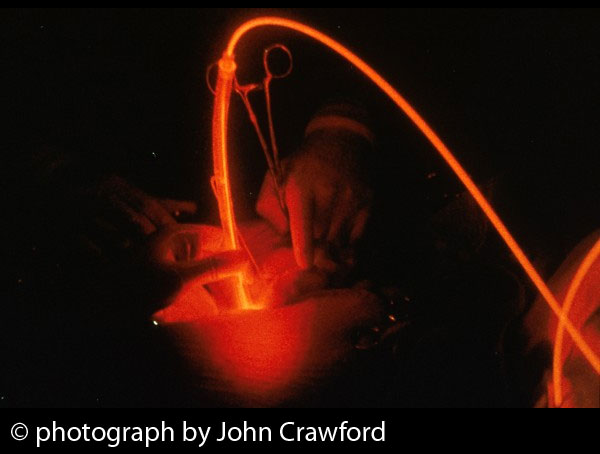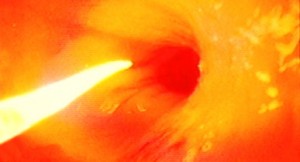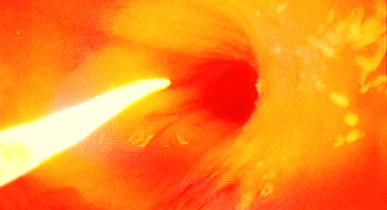Treating Stomach Cancer with PDT: How Far Have We Come?
Though Photodynamic therapy (PDT) is now well over a century old and has been clinically approved for treating various cancers, most oncologists view it as a relatively new form of cancer therapy. Clinical evidence supporting the use of PDT began to emerge in the 1970s. This evidence has steadily accumulated since that time, helping to fuel the medical community’s growing interest in PDT. Much of this interest is due to the treatment’s favorable track record against stomach cancer as well as other cancers that continue to thwart even the most aggressive forms of conventional treatment.
PDT involves the use of a nontoxic photosensitizing agent that selectively concentrates in the tumor, usually over the course of several hours. The tumor is then exposed to visible light, which results in a photochemical reaction that destroys the tumor. The best photosensitizers also activate the anti-cancer immune defenses.
How does PDT measure up against such mainstream treatments as radiotherapy or chemotherapy? A major limitation of these treatments is their dose-limiting toxicity, meaning that the treatment must be discontinued if toxic side effects become too severe. PDT is not subject to dose-limiting toxicity, and thus it offers an increasingly attractive “adjuvant” therapy that could be integrated into the standard treatment regimen.
PDT’s ability to generate an immune response against cancer is another major reason this therapy is gaining traction in the world of oncology. The anti-cancer immune response occurs as a result of PDT’s ability to elicit the release of “damage-associated molecular patterns” (DAMPs), along with tumor antigens (proteins that help the immune system identify the tumor as “foreign”). If PDT and other strategies can elicit this potent immune response following treatment, the treatment could be used to help mop up any disease that remains after conventional treatments.
Stomach cancer is an example of a disease that has heretofore defied the best efforts of modern oncology. Surgery’s benefits are often short-lived, and radiotherapy and chemotherapy are only stop-gap measures in the majority of cases. If PDT can be successfully combined with standard treatments for stomach cancer, it could help solve the problems of recurrent and metastatic disease—problems that account for the great majority of deaths from this terrible disease.
Asian Countries Seek PDT for Stomach Cancer Crisis
On an international scale, stomach cancer is most common in Eastern Asia and Eastern Europe. This cancer represents an immense burden in Asian countries in particular. For example, in Japan, about 50,000 men and women die from stomach cancer each year. In China, mortality from stomach cancer is the highest in the world, while in Korea, stomach cancer is second only to colon cancer as a cause of cancer death.
The key factor influencing the choice of a specific treatment for stomach cancer is the stage—that is, how far the cancer has progressed. If the cancer is confined to the mucosa and the submucosa of the stomach wall, the chance of curing the disease is fairly high. It is important to understand, however, that “curing” in this case simply means elimination of all visible signs of the cancer. In many cases, the cancer will return within a year or two, and such recurrences inevitably result in a far more lethal disease situation.
Surgery is considered to be the most important treatment for stomach cancer, particularly if the cancer has not yet spread beyond the stomach. The extent of the disease within the stomach will determine whether a large part of the stomach or all of the stomach will need to be removed—that is, either a partial or total gastrectomy. For example, a total gastrectomy is recommended in the case of either the “diffuse-type” stomach cancer, or when cancer is found in the middle-third section of the stomach.
What the Clinical Research Showed 25 Years Ago
Most of the initial clinical investigations of PDT came out of Southeast Asia, where there has long been a sense of urgency with regard to finding more effective ways to treat stomach cancer. It seems the medical-scientific communities in those countries may be more willing to consider innovative options as well as reasonable alternatives to the standard treatment trio of surgery, radiotherapy, and chemotherapy.
We can look back approximately 25 years for the first hopeful indications from clinical studies of PDT for stomach cancer. The greatest promise was initially found for stomach cancer cases that could not be treated surgically.
For example, a 1990 study at the Kobe University School of Medicine (Japan) focused on laser-based PDT for eight cases of early stomach cancer. Three patients had refused to have surgery, and the others were in a high-risk group due to old age or complications with other diseases.
Using Photofrin-PDT, a local cure was achieved in seven of eight cases, and only one of the patients had a recurrence. This study indicatd that suggests that the Photofrin-PDT with a pulsed gold vapor laser was a clinically useful treatment for early-stage stomach cancer, as reported in the October 1990 Journal of Clinical Laser Medicine & Surgery.
In a multicenter research study project team based at Tokyo Medical College and organized by Japan’s Ministry of Health and Welfare, PDT was used to treat 120 cases of early-stage stomach tumors. This light-based treatment resulted in a 100% complete response and 22% recurrence rate—excellent results when compared to standard surgery. There were no recurrences in the smaller stomach cancers, i.e., those lesions measuring less than one centimeter in diameter, as reported in September 1990 issue of the Japanese medical journal, Gan To Kagaku Ryoho.
In that same year, researchers at the National Cancer Center Hospital in Tokyo, Japan reported on the use of PDT for superficial esophageal cancer and for ill-defined lesions of early-stage stomach cancer. They used an argon dye laser, with hematoporphyrin as the photosensitizer. Endoscopic laser PDT was carried out on 80 patients with 86 lesions of early-stage stomach cancer.
The Tokyo researchers concluded that intestinal-type (then referred to as “gastritis-like”) stomach tumors were highly curable by these means. In this study, PDT was fairly effective, especially in smaller lesions (less than two centimeters in size) of early-stage stomach cancer.
European Studies from 1990: PDT’s Promise Confirmed
A pilot study by researchers at the Hôpital Guillaume et René Laënnec in Nantes, France used a hematoporphyrin derivative as the photosensitizer for endoscopic PDT as a primary treatment for inoperable gastrointestinal cancers. This study enrolled 54 patients, 14 of whom suffered from stomach cancer (gastric adenocarcinoma). After infusion of the hematoporphyrin derivative, lesions were exposed to an argon dye laser.
During a follow-up period averaging 14.5 months, complete tumor destruction was observed in 50% of cases. The mean recurrence-free period varied from about 14 to 17 months. The findings from this study indicate the potential efficacy of PDT as a curative treatment for select cases of inoperable stomach cancer and other gastrointestinal cancers, possibly in association with locoregional radiotherapy, as reported by Dr. Thierry Patrice and his research team in the May 1990 issue of Digestive Diseases and Sciences.
That same year, scientists at the National Oncological Center in Sofia, Bulgaria studied the effects of PDT in six patients with early-stage gastrointestinal cancer, two of whom had stomach cancer. Pure hematoporphyrin using a slow intravenous infusion was administered 72 hours prior to treatment, and PDT was performed with an argon-pumped dye laser; the latter was done in both single and multiple treatment sessions.
The main findings were as follows: A complete response was obtained in each of the patients, and no early or late treatment-related complications were recorded. The patients were observed for up to 16 months after treatment, and no local recurrence or progression of disease (metastases) was reported.
Despite the small size of this study, the findings do suggest that PDT for early-stage stomach cancer and other early-stage gastrointestinal carcinomas is a “radical therapeutic method in clinical oncology,” as subsequently reported by the authors in the 1991 issue of Lasers in Surgery and Medicine.
As you can see, PDT was showing very impressive clinical results even as long as 25 years ago! One would think the therapy would be more widely accepted as a first-line treatment for early-stage stomach cancer, and yet only a few countries have been able to place it on a par with surgery for treating this this condition.
Photograph is courtesy of Dr. Vladimir Romanov and shows the photodynamic treatment of stomach cancer, resulting in elimination of all malignant lesions. These findings were presented at the 14th World Congress of the International Photodynamic Association.
Back to the Future: Russian Study of Bremachlorin Offers a Breakthrough
Fortunately, we’ve come a long way since 1990. Evidence for this progress was presented by Dr. Vladimir Romanov in May 2013 at the 14th World Congress of the International Photodynamic Association (IPA), in Seoul, South Korea. (READ MORE for a complete discussion of these findings along with a graphic description of the different stages of treatment.)
In a pilot clinical trial, Dr. Romanov and colleagues studied 65 patients with mainly early-stage stomach cancer (average age: 70 years old) who were treated using the photosensitizer Bremachlorin®. Of this group, 50 patients were at a high risk of post-surgical complications, five patients had rejected surgery, and 10 patients were in palliative care due to the advanced nature of their disease.
A total of 264 photodynamic treatment sessions were performed, and each patient received from one to 23 sessions, with treatments taking place over a five-year period. During this time, a biopsy was done twice a year, then once a year for the next five years.
The most effective Bremachlorin-PDT treatment schedule was found to be three sessions in the first year and two sessions in each of the subsequent years. Two patients with the most severe forms of stomach cancer received 23 treatments each and have stayed alive for eight years at the time of this writing. Every patient responded in some way to the treatment, and the overall treatment benefit during the first five years for every patient can be summarized as follows:
- 35% had a complete response
- 49% had a partial response
- 15% showed disease stabilization
- 1% showed disease progression
Thirty percent of the patients had recurrences of their tumors and were treated repeatedly, without any serious side effects. Some patients complained of symptoms related to the rapid breakdown of the tumor tissues. These symptoms included pain in the upper central region of the abdomen (epigastrium), as well as nausea and toxic effects that were managed using standard medications and techniques.
Given the scope and magnitude of this problem, it is not surprising that so many medical scientists from Japan, Korea and other Asian countries have come to regard PDT as a reasonable alternative to conventional surgery. The Romanov study indicates that Bremachlorin-PDT is a highly promising treatment for stomach cancer, and that its combination with PDD (to assist with monitoring as well as debulking surgery) should continue to receive serious research attention in the months and years ahead.
Support us by buying our book, The Medicine of Light, and ebooks from our Photoimmune Discoveries eBook Series.
Sources
Brodin NP, Guha C, Tomé WA. Photodynamic Therapy and Its Role in Combined Modality Anticancer Treatment. Technol Cancer Res Treat. 2014 Nov 5.. [Epub ahead of print]
Kishi K, Fujiwara Y, Yano M, Motoori M, Sugimura K, Ohue M, Noura S, Marubashi S, Takahashi H, Sakon M. Diagnostic laparoscopy with 5-aminolevulinic-acid-mediated photodynamic diagnosis enhances the detection of peritoneal micrometastases in advanced gastric cancer. Oncology. 2014;87(5):257-65.
Nakamura T1, Ejiri M, Fujisawa T, Akiyama H, Ejiri K, Ishida M, Fujimori T, Maeda S, Saeki S, Baba S. Photodynamic therapy for early gastric cancer using a pulsed gold vapor laser. J Clin Laser Med Surg. 1990 Oct;8(5):63-7.
Kato H, Kito T, Furuse K, Sakai E, Ito K, Mimura S, Okusima N, Naito K, Suzuki S. Photodynamic therapy in the early treatment of cancer]. [Article in Japanese] Gan To Kagaku Ryoho. 1990 Sep;17(9):1833-8.
Li JH, Guo ZH, Jin ML, Zhao FY, Cai WM, Gao ML, Shu MY, Zou J. Photodynamic therapy in the treatment of malignant tumours: an analysis of 540 cases. J Photochem Photobiol B. 1990 Jun;6(1-2):149-55.
Patrice T, Foultier MT, Yactayo S, Adam F, Galmiche JP, Douet MC, Le Bodic L. Endoscopic photodynamic therapy with hematoporphyrin derivative for primary treatment of gastrointestinal neoplasms in inoperable patients. Dig Dis Sci. 1990 May;35(5):545-52.
© Copyright 2015, Photoimmune Discoveries, BV









 English
English Français
Français Deutsch
Deutsch Nederlands
Nederlands